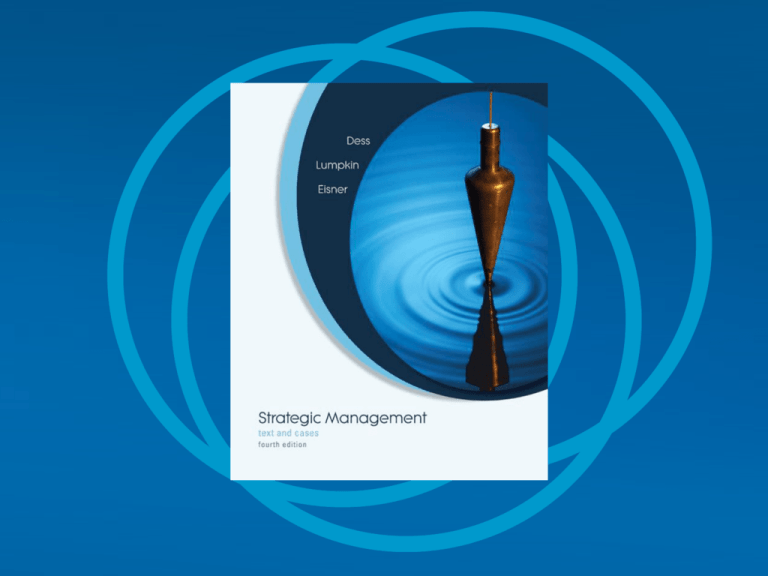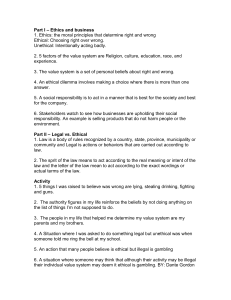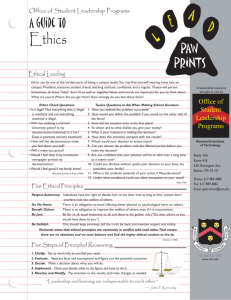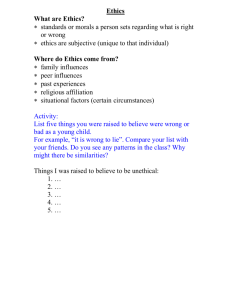
11
Strategic Leadership:
Creating a Learning Organization
and an Ethical Organization
McGraw-Hill/Irwin
Strategic Management: Text and Cases, 4e
Copyright © 2008 The McGraw-Hill Companies, Inc. All rights reserved.
1 1- 3
Learning Objectives
•
After reading this chapter, you should have a
good understanding of:
-
-
-
The three key activities in which all successful
leaders must be continually engaged.
The importance of recognizing the interdependence
of the three key leadership activities, and the
salience of power in overcoming resistance to
change.
The crucial role of emotional intelligence (EI) in
successful leadership as well as its potential
drawbacks.
The value of creating and maintaining a “learning
organization” in today’s global marketplace.
1 1- 4
Learning Objectives
•
After reading this chapter, you should have a
good understanding of:
-
The five central elements of a “learning
organization.”
The leader’s role in establishing an ethical
organization.
The benefits of developing an ethical organization.
The high financial and nonfinancial costs associated
with ethical crises.
1 1- 5
Leadership: Three
Interdependent Activities
• Leadership is the process of transforming
organizations from what they are to what the
leader would have them become
• Leadership should be
- Proactive
- Goal-oriented
- Focused on the creation and implementation of a
creative vision
1 1- 6
Leadership: Three
Interdependent Activities
Successful
leaders must
recognize three
interdependent
activities:
Adapted from Exhibit 11.1 Three Interdependent Activities of Leadership
1 1- 7
Setting a Direction
• Scan environment to develop
- Knowledge of all stakeholders
- Knowledge of salient environmental trends and events
• Integrate that knowledge into a vision of what the
organization could become
• Required capacities
- Solve increasingly complex problems
- Be proactive in approach
- Develop viable strategic options
1 1- 8
Example
• DuPont’s vision statement is “to be the world's
most dynamic science company, creating
sustainable solutions essential to a better, safer
and healthier life for people everywhere.”
Source: www.dupont.com
1 1- 9
Designing the Organization
• Difficulties in implementing the leaders’ vision
and strategies
- Lack of understanding of responsibility and
accountability among managers
- Reward systems that do not motivate individuals and
groups toward desired organizational goals
- Inadequate or inappropriate budgeting and control
systems
- Insufficient mechanisms to coordinate and integrate
activities across the organization
1 1- 10
Nurturing a Culture
• In nurturing a culture dedicated to excellence and
ethical behavior, managers and top executives must
- Accept personal responsibility for developing and
strengthening ethical behavior
- Consistently demonstrate that such behavior is central
to the vision and mission
- Develop and reinforce
• Role models
• Corporate credos
• Codes of conduct
- Reward and evaluation systems
- Policies and procedures
1 1- 11
Overcoming Barriers to Change and
the Effective Use of Power
• Reasons why organizations and managers at all
levels are prone to inertia and slow to learn,
adapt, and change
-
Vested interests in the status quo
Systemic barriers
Behavioral barriers
Political barriers
Personal time constraints
1 1- 12
A Leader’s Bases of Power
Exhibit 11.2 A Leader’s Bases of Power
1 1- 13
Emotional Intelligence: A Key
Leadership Trait
Successful traits
of leaders at the
highest level
Technical
skills
Cognitive
abilities
Accounting,
business
planning, etc.
Analytical reasoning,
quantitative analysis,
etc.
Emotional
intelligence
Ability to work with
others, passion for
work, etc.
1 1- 14
Emotional Intelligence
• Five components of emotional intelligence
-
Self-awareness
Self-regulation
Motivation
Empathy
Social skill
1 1- 15
Five Components of Emotional
Intelligence at Work
Definition
Self-management
skills:
• Selfawareness
• The ability to recognize
and understand your
moods, emotions, and
drives, as well as their
effect on others.
• Self-regulation • The ability to control or
redirect disruptive
impulses and moods.
• The propensity to
suspend judgment—to
think before acting.
Hallmarks
• Self-confidence
• Realistic selfassessment
• Self-deprecating sense
of humor
• Trustworthiness and
integrity
• Comfort with ambiguity
• Openness to change
Source: Adapted from D. Goleman, “What Makes a Leader,” Harvard Business Review, October-November 1998, p. 95 (with permission)
Adapted from Exhibit 11.3 The Five Components of Emotional Intelligence at Work
1 1- 16
Five Components of Emotional
Intelligence at Work
Definition
Self-management
skills:
• Motivation
Managing
Relationships:
• Empathy
Hallmarks
• A passion to work for
• Strong drive to achieve
reasons that go beyond • Optimism, even in the
money or status.
face of failure
• A propensity to pursue • Organizational
goals with energy and
commitment
persistence.
• The ability to
understand the
emotional makeup of
other people.
• Skill in treating people
according to their
emotional reactions.
Adapted from Exhibit 11.3 The Five Components of Emotional Intelligence at Work
• Expertise in building
and retaining talent
• Cross-cultural
sensitivity
• Service to clients and
customers
1 1- 17
Five Components of Emotional
Intelligence at Work
Definition
Managing
Relationships:
• Social Skill
Hallmarks
• Proficiency in managing
relationships and
building networks.
• Effectiveness in leading
change
• An ability to find
common ground and
build rapport.
• Expertise in building
and leading teams
• Persuasiveness
Source: Adapted from D. Goleman, “What Makes a Leader,” Harvard Business Review, October-November 1998, p. 95 (with permission)
Adapted from Exhibit 11.3 The Five Components of Emotional Intelligence at Work
1 1- 18
Developing a Learning Organization
• Successful learning organizations
- Create a proactive, creative approach to the unknown
- Actively solicit the involvement of employees at all
levels
- Enable all employees to use their intelligence and
apply their imagination
• Learning environment
-
Organization-wide commitment to change
An action orientation
Applicable tools and methods
Guiding philosophy
Inspired and motivated people with a purpose
1 1- 19
Key Elements of a
Learning Organization
1 1- 20
Key Elements of a
Learning Organization
• Empowering employees at all levels
- Salient elements of empowerment
• Start at the bottom by understanding needs of
employees
• Teach employees skills of self-management
• Build teams to encourage cooperative behavior
• Encourage intelligent risk taking
• Trust people to perform
1 1- 21
Question
Do you agree with this statement by Ken Melrose,
“the great leader is a great servant”?
1 1- 22
Key Elements of a
Learning Organization
• Accumulating and sharing internal knowledge
- “Open book” management
• Numbers on each employee’s work performance and
production costs generated daily
• Information is aggregated once a week from top level to
bottom level
• Extensive training in how to use and interpret the
numbers – how to understand balance sheets, cash
flows and income statements
1 1- 23
Key Elements of a
Learning Organization
• Gathering and integrating external information
- Awareness of environmental trends and events
• Internet accelerates the speed with which useful
information can be located
• “Garden variety” traditional sources for acquisition of
external information
• Benchmarking
• Focus directly on customers for information
1 1- 24
Key Elements of a
Learning Organization
• Challenging the status quo and enabling
creativity
- Challenging the status quo
•
•
•
•
Create a sense of urgency
Establish a “culture of dissent”
Foster a culture that encourages risk taking
Cultivate culture of experimentation and curiosity
1 1- 25
Creating An Ethical Organization
• Organizational ethics is a direct reflection of its
leadership
• Unethical business practices
- Involves tacit, if not explicit, cooperation of others
- Reflect the values, attitudes, and behavior pattern that
define the organization’s operating culture
• Driving forces of ethical organizations
- Ethical values
- Integrity
1 1- 26
Example
• In order to avoid unethical business practices,
you should never do the following:
1. Suppress information that might damage your
reputation.
2. Deny charges that are relevant and factual.
3. Spend money for public relations or advertising to
counter honest complaints.
4. Ignore problems with the products you sell.
5. Refuse to accept blame.
Source: Gerson, Vicki. “Avoiding Unethical Business Practices,” www.nfib.com. February 21, 2003.
1 1- 27
Creating An Ethical Organization
• Ethical values
- Shape the search for opportunities
- Shape the design organizational systems
- Shape the decision-making process used by
individuals and groups
- Provide a common frame of reference that serves as a
unifying force
1 1- 28
Integrity-Based versus Compliance-Based
Approaches to Organizational Ethics
• Essential links between organizational integrity
and individual integrity
- Cannot be high-integrity organizations without highintegrity individuals
- Individual integrity is rarely self-sustaining
- Organizational integrity, resting on a concept of
• Purpose
• Responsibility
• Ideals
1 1- 29
Question
Integrity-based ethics programs combines a
concern for law with an ______.
A) emphasis on the proper use of managerial
power
B) emphasis on legal consequences of unethical
behavior
C) emphasis on managerial responsibility for ethical
behavior
D) emphasis on social responsibility for ethical
behavior
1 1- 30
Approaches to Ethics Management
Characteristics Compliance-Based
Approach
Integrity-Based
Approach
Ethics
Conformity with externally Self-governance according to
imposed standards
chosen standards
Objective
Prevent criminal
misconduct
Enable responsible conduct
Leadership
Lawyer-driven
Management-driven with aid of
lawyers, HR, and others
Source: L. S. Paine, “Managing for Organizational Integrity,” Harvard Business Review 72, no. 2 (1994), p. 113 (with permission).
Adapted from Exhibit 11.6 Approaches to Ethics Management
1 1- 31
Approaches to Ethics Management
Characteristics Compliance-Based
Approach
Integrity-Based
Approach
Methods
Education, reduced
discretion, auditing and
controls, penalties
Education, leadership,
accountability, organizational
systems and decision
processes, auditing and
controls, penalties
Behavioral
Assumptions
Autonomous beings
guided by material
self-interest
Social beings guided by
material self-interest, values,
ideals, peers
Source: L. S. Paine, “Managing for Organizational Integrity,” Harvard Business Review 72, no. 2 (1994), p. 113 (with permission).
Adapted from Exhibit 11.6 Approaches to Ethics Management
1 1- 32
Key Elements of Highly
Ethical Organizations
• These interrelated elements must be present and
constantly reinforced
-
Role models
Corporate credos and codes of conduct
Reward and evaluation systems
Policies and procedures
1 1- 33
Key Elements of Highly
Ethical Organizations
• Role Models
- Leaders are role models for their organizations
- Leaders must be consistent in their words and deeds
- Values and character of leaders become transparent
to an organization’s employees
- Effective leaders take responsibility for ethical lapses
within the organization
1 1- 34
Key Elements of Highly
Ethical Organizations
• Corporate credos and codes of conduct
- Provide a statement and guidelines for norms, beliefs
and decision making
- Provide employees with clear understanding of the
organizations position regarding employee behavior
- Provide the basis for employees to refuse to commit
unethical acts
- Contents of credos and codes of conduct must be
known to employees
1 1- 35
Key Elements of Highly
Ethical Organizations
• Reward and evaluation systems
- Inappropriate reward systems may cause individuals
at all levels of the organization to commit unethical
acts that they might not otherwise do
- Penalties in terms of damage to reputations, human
capital erosion, and financial loss are typically much
higher than any gains that could be obtained through
such unethical behavior
1 1- 36
Key Elements of Highly
Ethical Organizations
• Policies and procedures
- Policies and procedures can specify proper
relationships with a firm’s customers and suppliers
- Policies and procedures can guide employees to
behavior ethically
- Policies and procedures must be reinforced
•
•
•
•
Effective communication
Enforcement
Monitoring
Sound corporate governance practices







